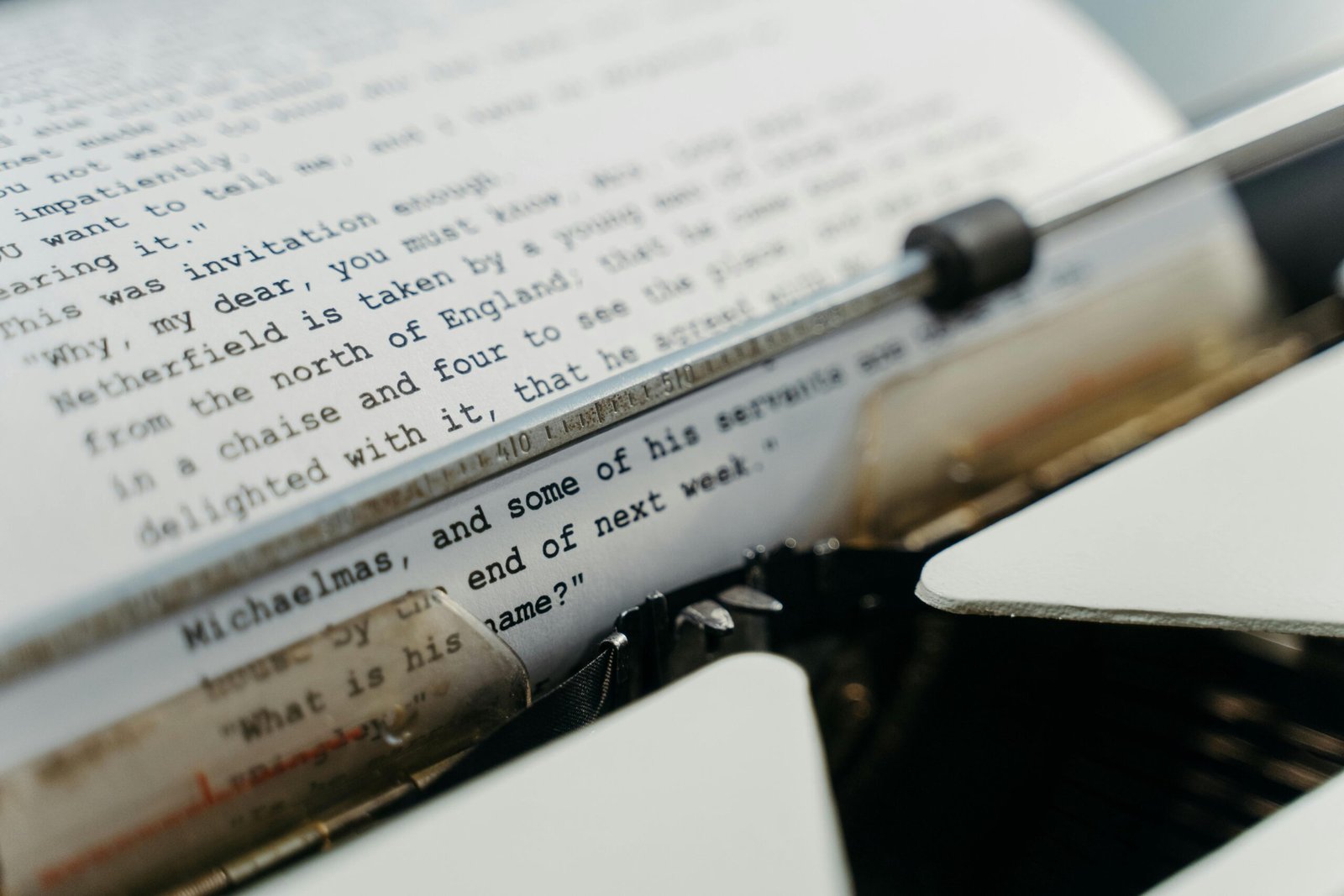I first used a figurative language finder tool when I went looking for Riverdale’s the day before figurative language. The goal was to try to find metaphors, similies, hyperbole, idioms, etc.. Although there aren’t many AI tools dedicated to scanning scripts of your favorite poem or that captivating novel you’re reading to find the figurative language used in them, I could recommend a few.
These figurative language finder tools are important because we can agree that they make work easier and save a lot of time that one would have used trying to figure out the figurative language used in something you’ve read. Creating impactful, vivid language can be challenging without the relevant assistance. Fortunately, I have lined up a few of the best AI-powered figurative language finder tools that will assist in making the process faster and more creative.
This article covers the best tools for finding and generating figurative language, so you can improve your writing with ease.
Featured Figurative Language Finder Tools
What is figurative language?
Figurative language is a language you see when words or phrases are used in a non-literal way to add richness and layers of meaning to text. Examples include:
- Metaphors: Comparing two things directly (e.g., “Time is a thief”).
- Similes: Comparing things using “like” or “as” (e.g., “white as the snow”).
- Personification: giving human traits to non-human elements (e.g., “The wind whispered”).
Using figurative language helps convey emotions and imagery in a memorable way. But knowing when and how to use the language effectively can be tricky, especially if you’re aiming to create content that resonates with readers. Besides, it can prove tiring when you’re looking for the figurative language used in your favourite novel/book.
Top Features of Figurative Language Finder Tools
When looking for the right figurative language finder tool, be sure to use the checklist outlined below.
- Does the tool have a user-friendly interface?
- Is the tool AI integrated? In this case, the best figurative language finder tools often have AI algorithms that generate and suggest figurative language ideas.
- Can you customize your search? Does the tool allow you to specify the figurative language type you want, e.g., metaphor, simile, hyperbole, etc., for tailored results?
Best Figurative Language Finder & Generator Tools
1. ClipMove
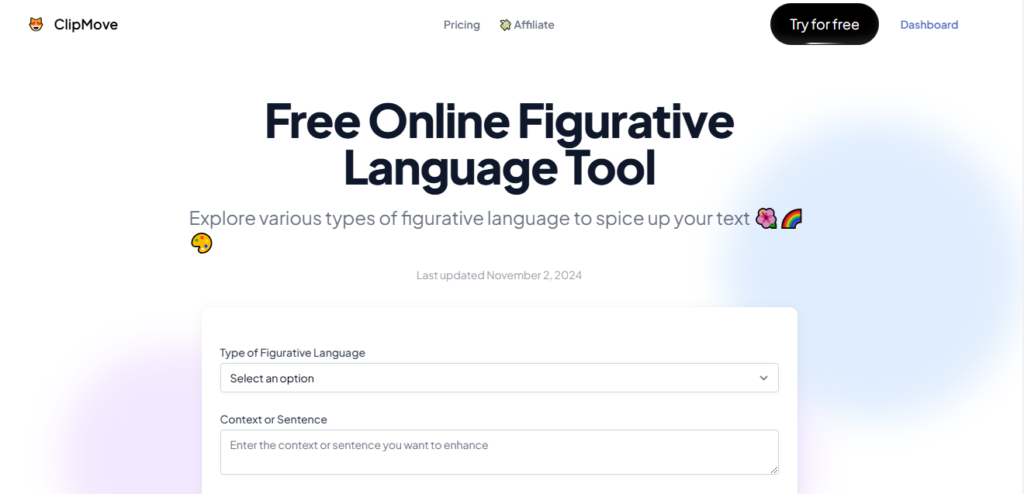
ClipMove is an online AI tool that helps you generate figurative language used in any sentence that you prompt it to search. With its straightforward design, ClipMove makes it easy to enter and analyze the context or sentence in real-time.
Step-by-step guide on how to use ClipMove to find figurative language
- Sign up to Clipmove
- Enter the sentence you want to generate the figurative language
- Give the tool additional instructions if need be.
- Select the language you want the results to be in
- Press the generate button.
It’s so straightforward to use ClipMove. You get results in seconds.
Pros of ClipMove:
- Simple to use, ideal for beginners.
- It can generate the output in multiple languages (it doesn’t seem to work though).
Cons:
- Features like superior performance, more customization options, faster generation, and Chrome Extension access are only accessible in the pro version.
2. Unifire.ai(Generator)
Unifire.ai is an online AI tool that works as a figurative language generator. Unifire AI can generate examples of figurative language based on the user prompts. This feature allows users to explore creative expressions and ideas that they might not have thought of on their own, which in turn inspires new ways to convey thoughts and emotions in writing.
For example, in the screenshot below, I entered the prompt ‘He is handsome’ and the tool quickly suggested examples of figurative language from the prompt. See below.
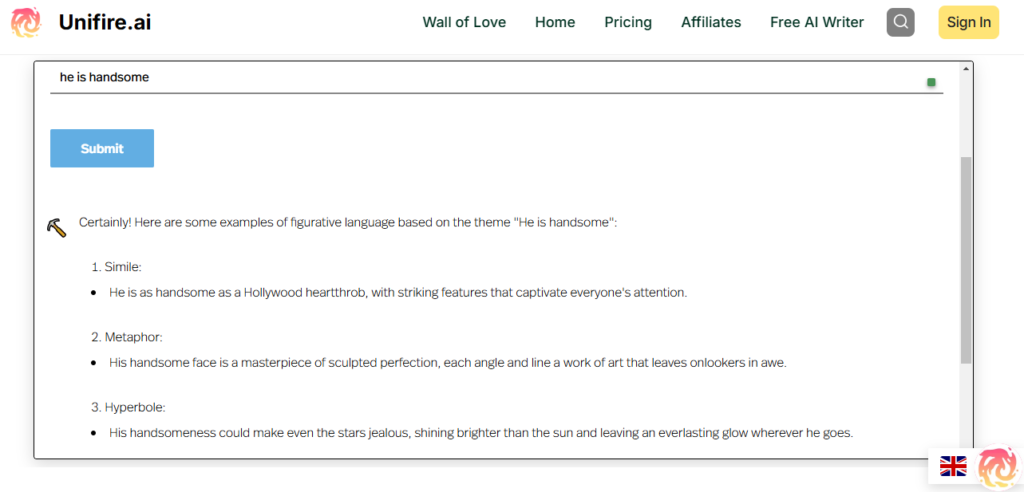
Step-by-step guide on how to use Unifire ai to find figurative language
- Open the tool
- Enter whatever text you want to generate figurative language ideas from
- Press submit
3. ChatGPT (Figurative Language Finder)
As of now, a huge percentage of internet users know that ChatGPT is capable of handling almost any request. Though not 100% factual, it comes in handy in generating and identifying figurative language used in a sentence. For example, let’s try and find Riverside the day before figurative language. You can see from the screenshot below the results returned by ChatGPT, which I am pretty happy with.
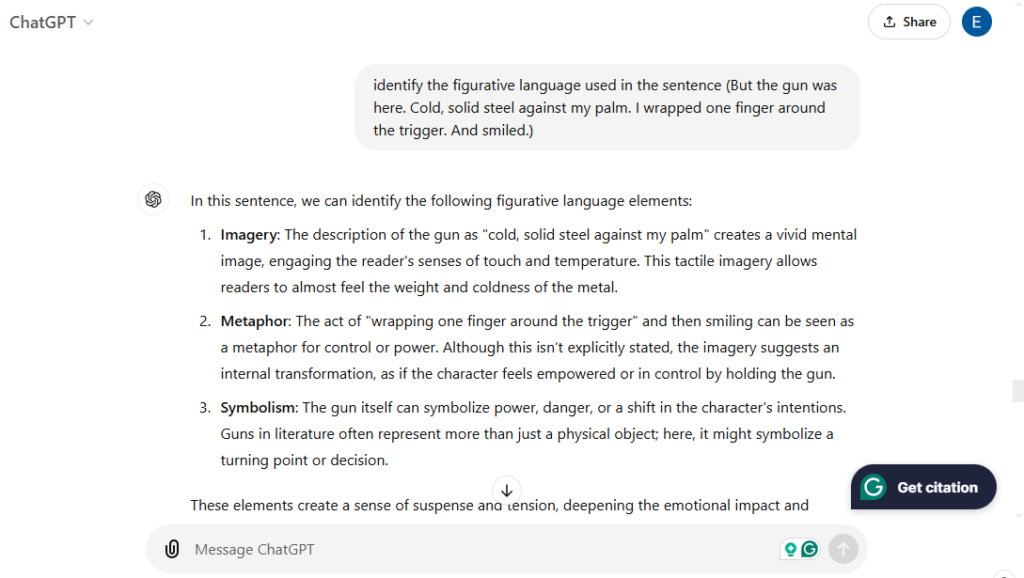
The good thing about ChatGPT in finding figurative language is;
- It has customizable responses, vast language capabilities, and real-time suggestions.
- High flexibility and creativity potential. The tool works well with specific prompts.
Cons:
It requires specific prompts for best results. The user needs to know a bit of prompt engineering
4. Rephrasely (Figurative Language Finder)
Rephrasely helps in finding figurative language by rephrasing sentences in ways that reveal whether a phrase is literal or figurative. When you input your sentence, Rephrasely checks the sentence and tells you if it contains figurative language and explains it or if it does not contain any figurative language. For instance, if “breaking the ice” gets rephrased as “starting a conversation,” you can tell the original phrase was figurative. This makes it a handy tool for identifying and understanding figurative language in text. Let’s take, for example, some of the figurative language used in the red pencil book. Let’s use ‘”When a storm of dust buries my home, I will dig myself out and rise again.” See the result below
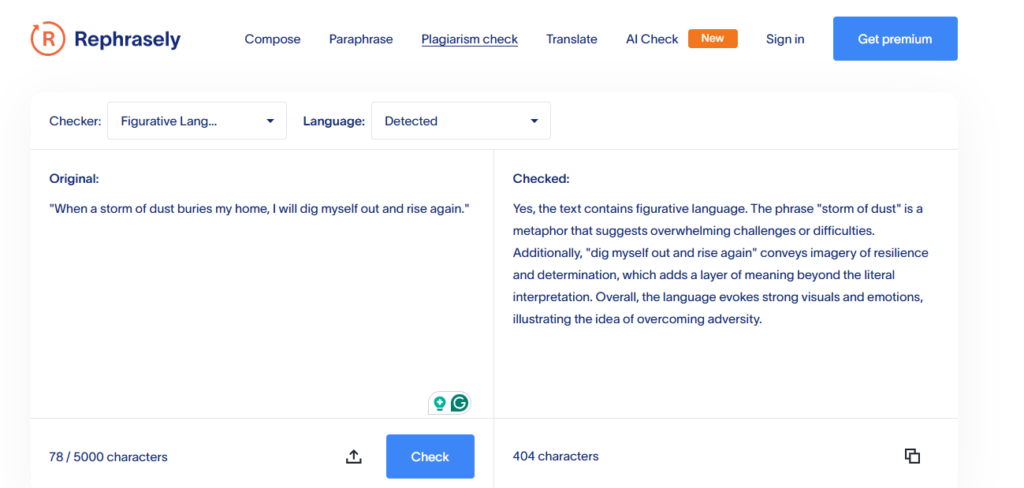
Step-by-Step Guide On How To Use Rephrasely To Find Figurative Language
- Open your web browser and go to the Rephrasely website.
- Write, paste or upload a document you want to check for figurative language into the text box
- Make sure the checker is highlighting “Figurative language.
- Press the check button to analyze your sentence or document.
Rephrasely is an easy-to-use tool for finding figurative language.
5. Figurative language checker
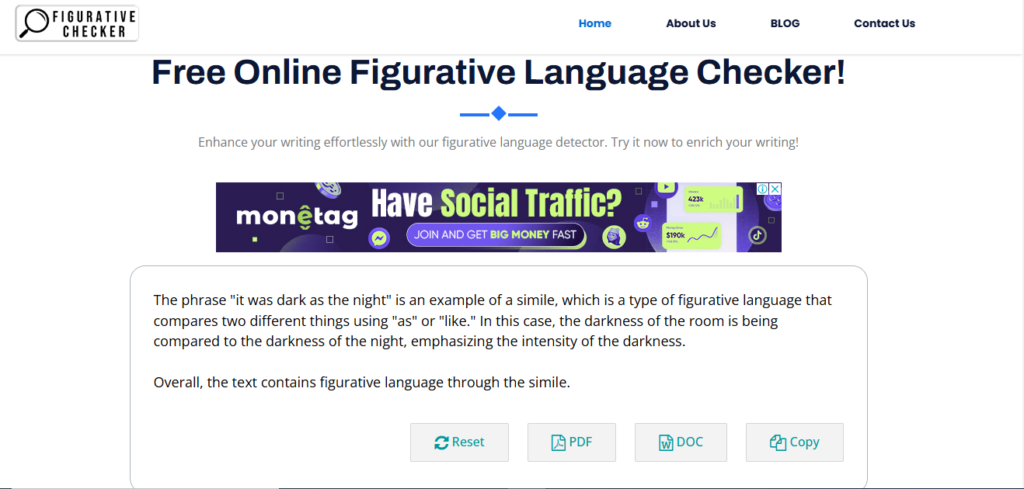
FigurativeLanguageChecker is a free online tool designed to help users find and understand figurative language in their writing. It highlights expressions like metaphors, similes, hyperboles, and other figures of speech; therefore, it makes it easier to see where creative language is used.
Step-by-Step Guide on How to Use Figurative Language Checker
- Go to FigurativeLanguageChecker.com.
- Copy the text you want to check for figurative language and paste it into the provided text box on the homepage.
- Click the Check button to start the process of scanning your input.
- After a moment, the tool will highlight phrases that use figurative language. It may label them as metaphors, similes, personifications, or other types, so you can easily identify each one.
Cons
FigurativeLanguageChecker does not offer customization options
Table Comparison Of The Best Figurative Language Finder Tools
Here’s a quick comparison to help you find the right tool:
| Tool | Key Features | Limitations |
|---|---|---|
| Clipmove.com | Contextual analysis, key phrase identification | May miss subtle figurative language; not designed specifically for it |
| Rephrasely | Multiple rephrasing modes, customizable for creativity | May lose nuanced meanings; detection not fully reliable |
| ChatGPT | Provides explanations and examples, customizable via queries | Requires user input; not a dedicated tool for scanning large text sections |
| FigurativeLanguageChecker.com | Highlighted phrases with possible explanations | Limited accuracy may flag literal phrases; explanations are basic |
| Unifire.ai | Identifies types of figurative language, provides explanations, and provides a generator option | Not always accurate; complex phrases may need additional user interpretation |
How to Use These Tools Effectively
Using figurative language finder tools effectively requires a few strategies:
- Experiment with Prompts: This is exactly what I did before writing this article. Try specific prompts and see if the tool is good enough for what you need to do
- Combine the tools: When finding a specific type of figurative language, combine tools like chatGPT and rephrasely and compare the results.
- Use the tools regularly to enhance your natural creativity over time.
Conclusion
After reading that sweet, captivating novel and you need to find the figurative language used in it, you’re at liberty to try one or all the above figurative finder tools to see the one that helps you solve your problem. These AI tools make the process swift, and they will definitely give you ample time to read your next novel.
FAQs
Can these tools replace a writing coach?
These tools are excellent for practice but should ideally complement human feedback for deeper insights.
Do I need experience to use these Figurative Language Finder Tools?
Most tools are user-friendly, though advanced features may need practice to master.
Are Figurative Language Finder Tools Free?
Many offer free versions with basic features; some require subscriptions for advanced options.

